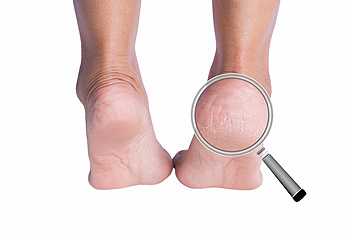Connect With Us
Blog
Items filtered by date: January 2023
Cracked Heels and Petroleum Jelly

Cracked heels are a condition that occurs when the heels of the feet do not receive sufficient moisture. As a result, the skin on the heels can grow hard and develop cracks or fissures. There are many treatments that your podiatrist might recommend to treat your cracked heels, which largely depends on your case. One potential remedy that your medical professional might suggest to treat your cracked heels is known as petroleum jelly. This substance will be able to lock moisture into the damaged skin on the cracked heels. The substance is gelatinous in texture and can be used on the skin. One might apply petroleum jelly to the feet by rubbing the jelly onto the feet at night and then wearing socks over the feet to lock in the moisture. If you are unsatisfied with the condition of your feet, contact a podiatrist today.
Cracked heels are unsightly and can cause further damage to your shoes and feet. If you have any concerns, contact Thi Pham, DPM from Foot Specialists of Tri-County. Our doctor can provide the care you need to keep you pain-free and on your feet.
Cracked Heels
Cracked heels appear unappealing and can make it harder for you walk around in sandals. Aside from looking unpleasant, cracked heels can also tear stockings, socks, and wear out your shoes. There are several methods to help restore a cracked heel and prevent further damage.
How Do You Get Them?
Dry skin is the number one culprit in creating cracked heels. Many athletes, walkers, joggers, and even swimmers suffer from cracked heels. Age and skin oil production play a role to getting cracked heels as well.
Promote Healing
Over the counter medicines can help, especially for those that need instant relief or who suffer from chronic dry feet.
Wear Socks – Wearing socks with medicated creams helps lock in moisture.
Moisturizers – Applying both day and night will help alleviate dryness which causes cracking.
Pumice Stones – These exfoliate and remove dead skin, which allows for smoother moisturizer application and better absorption into the skin.
Change in Diet
Eating healthy with a well-balanced diet will give the skin a fresh and radiant look. Your body responds to the kinds of food you ingest. Omega-3 fatty acids and zinc supplements can also revitalize skin tissue.
Most importantly, seek professional help if unsure how to proceed in treating cracked heels. A podiatrist will help you with any questions or information needed.
If you have any questions, please feel free to contact our offices located in Sulphur Springs, Winnsboro, and Pittsburg, TX . We offer the newest diagnostic and treatment technologies for all your foot care needs.
Are Bunions Affecting Your Everyday Life?
Exercising May Help to Prevent Falling

Falling can be a terrifying experience, and can be common among elderly people. One of the most effective methods to decrease the number of falls that happen to older people is to regularly exercise. This is beneficial in strengthening the overall body, and may help to prevent a bone from breaking during a fall. The feet can become affected during a fall, and may cause the patient an inability to complete daily activities. A good prevention technique consists of having a routine physical and eye examination, so existing glasses and medication can be monitored and updated, if necessary. Many people choose to have grab bars installed in the shower and toilet area, in addition to using a bathmat to avoid slipping. If you would like to learn more about how to implement fall prevention techniques, please speak with a podiatrist.
Preventing falls among the elderly is very important. If you are older and have fallen or fear that you are prone to falling, consult with Thi Pham, DPM from Foot Specialists of Tri-County. Our doctor will assess your condition and provide you with quality advice and care.
Every 11 seconds, an elderly American is being treated in an emergency room for a fall related injury. Falls are the leading cause of head and hip injuries for those 65 and older. Due to decreases in strength, balance, senses, and lack of awareness, elderly persons are very susceptible to falling. Thankfully, there are a number of things older persons can do to prevent falls.
How to Prevent Falls
Some effective methods that older persons can do to prevent falls include:
- Enrolling in strength and balance exercise program to increase balance and strength
- Periodically having your sight and hearing checked
- Discuss any medications you have with a doctor to see if it increases the risk of falling
- Clearing the house of falling hazards and installing devices like grab bars and railings
- Utilizing a walker or cane
- Wearing shoes that provide good support and cushioning
- Talking to family members about falling and increasing awareness
Falling can be a traumatic and embarrassing experience for elderly persons; this can make them less willing to leave the house, and less willing to talk to someone about their fears of falling. Doing such things, however, will increase the likelihood of tripping or losing one’s balance. Knowing the causes of falling and how to prevent them is the best way to mitigate the risk of serious injury.
If you have any questions, please feel free to contact our offices located in Sulphur Springs, Winnsboro, and Pittsburg, TX . We offer the newest diagnostic and treatment technologies for all your foot care needs.
Preventing Running Injuries With Gradual Changes

When an individual engages in running, it is possible that they may develop some kind of foot injury if the necessary measures are not taken. For instance, if the runner does not use proper form, they may be setting themselves up for a foot injury. However, runners may also be increasing the risk of injuring their feet by quickly or suddenly changing the nature of their workout. Namely, if a runner suddenly and dramatically increases the mileage of their daily run, then this might yield detrimental consequences. Instead of dramatically doubling or tripling the mileage, a runner might consider slowly and gradually increasing the mileage by 10% increments. This ensures that the feet are able to adapt to the longer distance. If you are a runner and are interested in protecting the feet, schedule an appointment with a podiatrist today.
Exercising your feet regularly with the proper foot wear is a great way to prevent injuries. If you have any concerns about your feet, contact Thi Pham, DPM of Foot Specialists of Tri-County. Our doctor will treat your foot and ankle needs.
How to Prevent Running Injuries
Many common running injuries are caused by overuse and overtraining. When the back of the kneecap starts wearing out and starts causing pain in your knee, this is commonly referred to as runner’s knee. Runner’s knee is a decrease in strength in your quadriceps and can occur if you’re not wearing properly fitted or supporting shoes. To prevent runner’s knee, focusing on hip strengthening is a good idea, as well as strengthening your quads to keep the kneecaps aligned.
What Are Some Causes of Running Injuries?
- One cause of a common running injury is called iliotibial band syndrome.
- Plantar fasciitis is also another common injury.
- Stress fractures can occur from overtraining, lack of calcium, or even your running style.
Best Ways to Prevent Running Injuries
- Wear footwear that fits properly and suits your running needs.
- Running shoes are the only protective gear that runners have to safeguard them from injury.
- Make a training schedule. Adding strengthening exercises as well as regular stretching can help keep you strong and limber and can lessen the possibility of injuries.
- Stretching keeps muscles limber; this will help you gain better flexibility.
If you have any questions please feel free to contact our offices located in Sulphur Springs, Winnsboro, and Pittsburg, TX . We offer the newest diagnostic and treatment technologies for all your foot and ankle needs.
How Obesity Affects the Feet

Extra weight can have a detrimental effect on your feet. Beyond achy and tired feet, problems from obesity can lead to arthritis in the feet. Overweight individuals might notice that their ankles become weaker as their weight increases, and this can lead to increased injuries. With obesity, there is also an increased chance of becoming diabetic, a condition that comes with a host of foot issues. Wearing supportive footwear is important to decrease the amount of strain put on the feet. Losing weight should be the focus of lessening how obesity affects the feet. Changing one’s diet is the most obvious way to help lose weight. Eating healthy foods and those that decrease inflammation is recommended. Diabetics need to make sure that they manage their blood sugar well. Even mild exercise will help in controlling weight. If you are obese and it is affecting your feet, seeing a podiatrist is suggested. This medical professional can help keep your feet as comfortable as possible while weight loss is undertaken.
The more you weigh, the harder your feet must work to support your body. If you’re an obese individual and are concerned about your feet, contact Thi Pham, DPM from Foot Specialists of Tri-County. Our doctor can provide the care you need to keep you pain-free and on your feet.
Obesity and Your Feet
People who are overweight are putting more pressure on their ankles, knees, and hips as well as their feet. This unfortunately can lead to variety of different issues.
Problems & Complications Stemming from Obesity
- When the body is overweight, it tries to compensate by changing the way that it moves. An obese person may lean forward and put extra weight on the wrong part of the foot. This puts unnecessary stress on the feet.
- Obese people are also more likely to develop type II diabetes which is a condition that causes a lot of foot problems. People with diabetes often don’t feel the cuts and sores that they may have on their feet, which can lead to more complicated and severe issues.
- Plantar fasciitis is another foot condition that can be caused by obesity. Plantar fasciitis is an inflammation of the tissue along the bottom of the foot, which causes pain and stiffness while walking and climbing stairs.
If you have any questions, please feel free to contact our offices located in Sulphur Springs, Winnsboro, and Pittsburg, TX . We offer the newest diagnostic and treatment technologies for all your foot care needs.
Plantar Fasciitis From Golf

Plantar fasciitis is inflammation of the plantar fascia, the thick band of connective tissue that supports the bottom of the foot. It is most often associated with high impact activities, like running, soccer, and football. One would not normally think of this condition with respect to a low impact game, like golf. However, in addition to trauma to the plantar fascia from high impact sports, plantar fasciitis can be caused by chronic overuse. Golf involves prolonged standing and walking. This can gradually flatten, inflame, and cause small tears in the arch of the foot, leading to heel pain and plantar fasciitis. Improperly swinging the golf club can also be a risk factor for plantar fasciitis. If one overextends while swinging, particularly while wearing shoes that do not support the heel and that might allow the foot to slide around, plantar fasciitis can result. Symptoms of this condition include extreme pain in the heel when walking, especially first thing in the morning. If you feel heel and arch pain that is interfering with your golf game and walking in general, consult with a podiatrist who can make an accurate diagnosis and provide treatment.
Ankle and foot injuries are common among athletes and in many sports. They can be caused by several problems and may be potentially serious. If you are feeling pain or think you were injured in a sporting event or when exercising, consult with Thi Pham, DPM from Foot Specialists of Tri-County. Our doctor will assess your condition and provide you with quality foot and ankle treatment.
Common Injuries
The most common injuries that occur in sporting activities include:
- Achilles Tendonitis
- Achilles Tendon Rupture
- Ankle Sprains
- Broken Foot
- Plantar Fasciitis
- Stress Fractures
- Turf Toe
Symptoms
Symptoms vary depending upon the injury and in some cases, there may be no symptoms at all. However, in most cases, some form of symptom is experienced. Pain, aching, burning, bruising, tenderness, tightness or stiffness, sensation loss, difficulty moving, and swelling are the most common symptoms.
Treatment
Just as symptoms vary depending upon the injury, so do treatment options. A common treatment method is known as the RICE method. This method involves rest, applying ice, compression and elevating the afflicted foot or ankle. If the injury appears to be more serious, surgery might be required, such as arthroscopic or reconstructive surgery. Lastly, rehabilitation or therapy might be needed to gain full functionality in the afflicted area. Any discomfort experienced by an athlete must be evaluated by a licensed, reputable medical professional.
If you have any questions, please feel free to contact our offices located in Sulphur Springs, Winnsboro, and Pittsburg, TX . We offer the newest diagnostic and treatment technologies for all your foot care needs.

